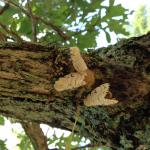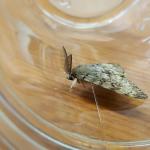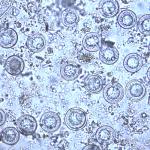Many areas suffered at the hands (or should we say mouthparts) of gypsy moth (Lymantria dispar) caterpillars this season in Massachusetts. This pest is well known to us in the Northeast. Accidentally introduced into Medford, MA in the 1860’s, gypsy moth has since spread throughout the Northeastern US and beyond. In a recent article featured on the UMass Center for Agriculture, Food, and the Environment’s web page, Dr. Joe Elkinton, entomologist and professor in the UMass Department of Environmental Conservation, observes that this is “the largest outbreak we’ve seen since 1981”. (For the full article, please read: Gypsy Moth Outbreak in Massachusetts, 2016.)
The caterpillars of this moth are voracious feeders that, when in large enough populations, can completely defoliate their host trees. White oak is a preferred host, but caterpillars will munch on the leaves of maple, birch, willow, poplar, apple, hawthorn, and many others. Needles of conifers such as pine and spruce are even devoured once favorable host plants have been stripped. Such feeding was observed by many in 2016.
Gypsy moth eggs were observed to be hatching by April 29th of this year in the Brimfield area. By May 27th reports were coming in from Carver, Hanson, Raynham, and Plymouth of caterpillars feeding. By June 10th, folks really started to notice the defoliation caused by this insect, as well as the caterpillars and the messes they make “coating everything”. Calls came from Sturbridge, Monson, Charlton, Northborough, and Westborough. By the end of June and the first week in July, the list of towns reporting extensive damage and frustration from gypsy moth caterpillars became too long to note. The Massachusetts Department of Conservation and Recreation (DCR) has aerially mapped defoliation across the state and attributes 352,774 acres of defoliation to gypsy moth feeding this year alone. A map of this defoliation can be seen here: 2016 Aerial Gypsy Moth Survey
By July 1st, pupation was well under way, and adult moths were seen shortly thereafter (brown males with black markings seen fluttering around in search of the flightless females which are white with black markings). Females have laid their eggs, boasting anywhere between 100-500 or more in each soft, brown mass plastered to the trunks and branches of host trees, outdoor lawn furniture, stairs, the sides of homes, and other seemingly indiscriminately chosen spots. The leftover mess of reddish-brown pupal cases, hairy cast larval skins, and caterpillar cadavers who succumbed (in unfortunately low numbers) to either the NPV (Nuclear Polyhedrosis Virus) virus or the fungus Entomophaga maimaiga can be found on host trees interspersed between egg masses. The Elkinton lab at UMass has observed that many host trees are refoliating, with the exception of some that may be also suffering from other insect pest, disease, or environmental stressors. The lack of significant rainfall in many areas of the state will only serve to stress trees defoliated by gypsy moth further.
So now that the feeding is over for this year, what does this mean for MA in 2017? Will gypsy moth devour the leaves of our trees and litter our patios with their hairy caterpillar bodies and frass (excrement) again? That may depend on whether or not the dry conditions observed in May of 2015 and June of 2016 are replicated again in the spring of 2017, according to the Elkinton lab. When this is the case, the gypsy moth killing fungus, Entomophaga maimaiga, cannot build up in the gypsy moth population early enough to kill caterpillars before they have a chance to defoliate our trees. However, if we do get a wet enough spring next season, the spores of this fungus are present in the environment and will be ready to “awake” and infect unsuspecting caterpillars. But timing is everything.
Most trees can handle defoliation and refoliate the same season. Multiple years of defoliation combined with other stressors can lead to tree mortality. Protecting ornamental shade trees from gypsy moth defoliation that could occur again in great quantities next year if we do not get enough well-timed rain, should be something managers plan for now. Management options can include hoping for a wet spring and that E. maimaiga will do all the work and kill caterpillars early, or utilizing chemical options on landscaped trees.
Unfortunately, mechanical and cultural options are too daunting and labor-intensive to provide enough relief. Scraping egg masses into jars of soapy water can be done where reached, but when high in the canopy, on the branches of host trees, this is unrealistic. And remember- every egg mass you miss could have 500 eggs waiting to become caterpillars next year. For similar reasons, banding trees with sticky materials to catch caterpillars, while it may be satisfying to know you caught a couple hundred: again- many will be missed. It is also never advisable to apply the sticky material directly to the bark of the tree. Finally, to address the questions about using motor oil and other such products to paint/spray egg masses: these practices are not recommended. Read the label - if it does not say to apply to manage gypsy moth or its life stages or at least Lepidopteran caterpillars, do not use it for such a purpose.
If you are seeing multitudes of gypsy moth egg masses on ornamental trees at this time which you wish to manage in 2017, plan your strategy now so you are not scrambling next year. Monitor egg hatch on susceptible trees next spring, which occurs around 90 GDD’s (base 50°F), generally in late April - early May, depending on the year. Check UMass Extension's Landscape Message for updates.
Once the caterpillars have finished ballooning to disperse, have settled to feed, and before they grow too large, treat the foliage with Bacillus thuringiensis (kurstaki), commonly known as B.t. This is a naturally occurring bacterium that is specific to caterpillars that become moths or butterflies (Lepidoptera). It is relatively safe for beneficial organisms and other insects. However, once the caterpillars are older, B.t. is much less effective.
To establish whether B.t. will work or not, inspect the caterpillars on the host plant; younger gypsy moth caterpillars have a head capsule that is all black while the older ones have obvious yellow markings on the head. In this case, other compounds, such as spinosad, may be necessary. Spinosad is also a naturally occurring substance made by a soil bacterium which is effective at managing gypsy moth, even when directed at older caterpillars, although treating the younger caterpillars is usually more effective. Avoid treating flowering hosts since spinosad, before it has time to dry, can be toxic to pollinators.
Other active ingredients labelled for use on gypsy moth include acephate, acetamiprid, azadirachtin, Bacillus thuringiensis subsp. aizawai, carbaryl, emamectin benzoate, insecticidal soap, permethrin, and tebufenozide. Horticultural oils may manage gypsy moth eggs and very young larvae, although as a tactic done alone, you may not achieve the results desired. Follow all instructions on product labels and be mindful of safety and environmental precautions.
Even though numerous chemical pesticides are available, it is best to manage problematic populations of this pest early and rely on B.t. or other least toxic insecticides as necessary.
While you think about your management plan, it can’t hurt to also hope for a wet spring.
Reported by Tawny Simisky, Extension Entomologist, UMass Extension Landscape, Nursery, & Urban Forestry Program




